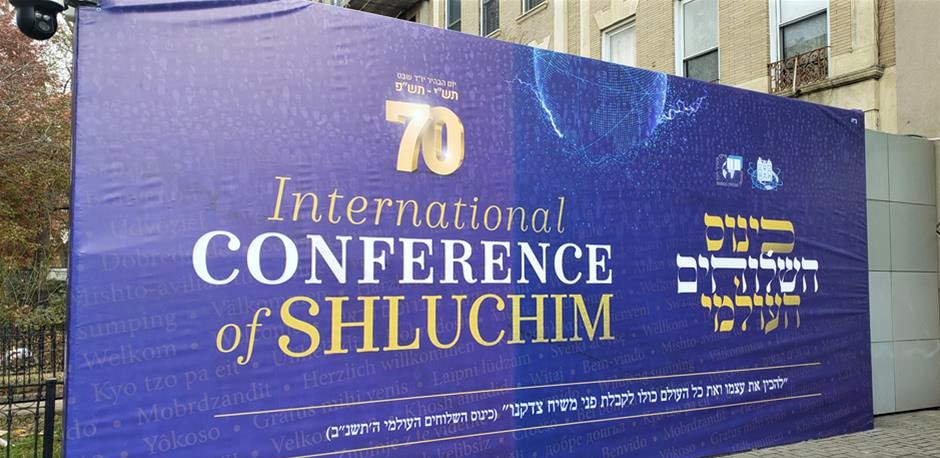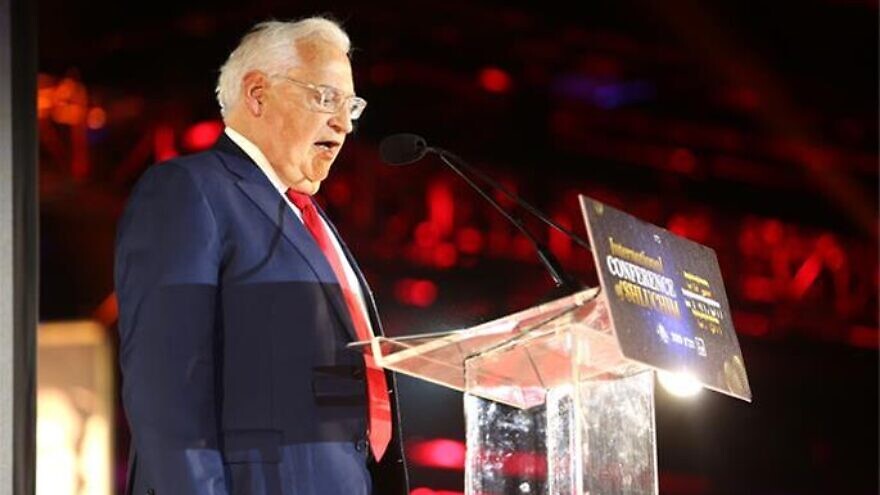Lettered and numbered circular tables lined the 150,000-square-foot New Jersey Convention Center, each one filled with a dozen rabbis and Jewish communal leaders, close to 6,000 people in all. They came together for the annual International Conference of Chabad-Lubavitch Emissaries (Kinus Hashluchim), which brings together Chabad rabbis and lay leaders from all 50 states and 100 countries, from California to Rwanda to Myanmar.
In a year of growing challenges for the Jewish people, with anti-Semitism increasing both domestically and worldwide, including the horrific shooting in April at Chabad of Poway that left one woman dead and three injured, the conference struck a defiant and positive tone, focusing on all the good that has been accomplished and all the work on behalf of the Jewish people yet to come.
The gathering comes as the world marks 25 years since the passing of the Rebbe, Rabbi Menachem M. Schneerson, who, following his ascension to the leadership of the Chabad movement 70 years ago, began sending emissaries around the world. What started as a handful of brave pioneers has grown into an army of 5,000 couples, rabbis and their wives, who leave home and hearth to serve Jewish communities, or, at times, build them from scratch, in places near and far.
A case in point was Rabbi Chaim Bar Sella of Kigali, Rwanda, who opened the evening by leading the assembled in reading a chapter of Psalms. Bar Sella and his wife, Dina, and their 11-month old son, Schneur Zalman, packed their bags in September and moved to the Central African nation, where together they established Chabad of Rwanda, as well as the country’s first-ever synagogue and Jewish center.
“The power, the energy, the love and brotherhood in this room is what makes all of the difference in the world. And it is in every one of you to share with each other and with all of the world.”
“My dear brothers,” Shalom read in his father’s name. “How I wish I could be here with you at the Kinus. The Baal Shem Tov says, ‘In the place where a person’s thoughts are that is where he is,’ so I feel that I am with you right here, right now.”
Hurwitz recalled receiving the chilling diagnosis, the news that he would lose his muscles, and then the ability to walk and then, the doctors said, his life. As he left the doctor’s office, he broke into a fit of tears. After composing himself, he walked out of the building and witnessed a man having a seizure, and ran over to help him.
“At that moment, I realized that there is still a lot that I can do,” said the man known by thousands simply as “Rabbi Yitzi,” through his son. “I resolved that no matter what the results of further tests, I was going to remain positive and find a way to make a difference. I couldn’t imagine how high that way of thinking would take me.”
He also acknowledged with appreciation the love, support, friendship and community of the brotherhood of emissaries during his time of need, and their ability to change the world, saying “the power, the energy, the love and brotherhood in this room is what makes all of the difference in the world. And it is in every one of you to share with each other and with all of the world.”
Concluding the speech, young Shalom looked into the camera and said “L’chaim” to his bedridden father. His was an emotional standing ovation.

The keynote address was given by U.S. Ambassador to Israel David Friedman, who recalled his first interaction with Chabad back in 1994, when Rabbi Zalman and Chani Wolowik established Chabad of the Five Towns in a little storefront in Woodmere, N.Y. It was, Friedman recalled, within a half-mile radius of probably 15 other synagogues, and he “thought the Chabad House had as much of a chance for success as a store selling ice cubes to Eskimos.”
But soon he formed a relationship with the young Chabad rabbi—one that led to them becoming Torah-study partners for decades. They studied Tanach, beginning with the book of Joshua, which Friedman says not only aided his Judaic studies, but prepared him for his current role as the American ambassador to Israel.
He also recalled how, during the weeks prior to the U.S. decision to move the American embassy to Jerusalem and other seminal events, Wolowik took Friedman to the Ohel, the Rebbe’s resting place in Queens, N.Y.
“It’s an oasis of spirituality,” he said. “An opportunity to contemplate what you really need, rather than what you think you want. To ask the Rebbe … to be an advocate for those needs. I’ve never left the Ohel feeling anything but optimism and joy.”
Rabbi Yitzchak Schochet, a Chabad emissary who has served as senior rabbi of the Mill Hill Synagogue in London since 1991, shared his personal recollection of a private audience with the Rebbe he had with his parents and family as a 3-year-old child. Hoping the Rebbe would bless him, he burst out crying when he mistakenly thought the Rebbe had not. When the Rebbe saw the little boy crying, he called him around to the side of his desk, placed his hands on his head and proceeded to bless him with the hallowed words of the priestly benediction.
The story, Schochet asserted, has a broader meaning and lesson.
“Because somewhere out there is a Jewish child who is crying; sometimes, the tears are readily discernible; other times—indeed, most often—they’re crying internally, sometimes such that they themselves may be oblivious to their own tears,” declared Schochet. “On the surface, they look strong, forthright, determined, but somewhere deep within, at the core, their souls are crying out.”
This, he explained, was the charge the Rebbe had given to his emissaries around the world, to travel out to all four corners of the world and soothe the crying Jewish child, whether literal or figurative, wherever he or she may be.
‘Where would the world be today?’
In a video presentation that followed, the camera followed the journeys of Rabbi Yehuda Weg, co-director of Chabad of Oklahoma in Tulsa; Rabbi Zeev Stiefel, co-director of Chabad of Piestany, Slovakia; and Rabbi Mendy Chitrik of Chabad of Istanbul in Turkey.
As the three-part video unfolded, the audience learned of the Jewish woman of Moroccan descent Weg discovered living on the dusty backroads of Oklahoma, the Slovakian Jew from Kosice who learned he was Jewish from his Holocaust-survivor grandmother on her deathbed and began growing closer to his Jewish roots via Stiefel, and the Turkish family that found out they were Jewish when their grandmother revealed that she, too, was a European Jew who had escaped to Turkey after the Holocaust to start a new life.
“Ask yourself, where would the world be today without the Rebbe’s vision? We just saw evidence of Holocaust survivors, and no one will have shed more tears than them,” said Schochet. “After the ineffable events of 80 years ago, they sought to disappear—in Slovakia, in Turkey—and who can judge them? But then again, who would have gone looking for them? What would have become of them, of their children, of their grandchildren; what would have become of a lost Jewish girl in the backwaters of Oklahoma were it not for the irrational, supra-rational and unconditional devotion of every shliach and shlucha?”
The evening wrapped up with the yearly Roll Call, during which Kotlarsky read out the names of the 100 countries and all 50 states with permanent Chabad emissaries. Announcing a new Chabad center in Myanmar (once called Burma), as well as one in Turks and Caicos, a Carribean island known for its white beaches and blue water but not its Jewish infrastructure, Kotlarsky ended off with his now-trademark “A round of applause for the whole world!” before the room broke out into scheduled, but nonetheless very much spontaneous, dance.
As thousands danced through a maze of converging circles—ID tags and black hats bouncing to the upbeat sounds of Chassidic music—Ron Kramer of S. Monica, Calif., said it was this moment he had come for. Kramer, an entrepreneur with homes in Arizona and the beachside city of S. Monica, met Rabbi Eli Moshe Levitansky, co-director of Chabad of S. Monica College (SMC) nine years ago, when they began a weekly Torah-study session. This is his sixth Kinus, and if anything encapsulates why he keeps coming back, it’s the dancing
“I come to get the essence,” he said. “I come to feel the energy.”
This article first appeared on Chabad.org.News.


























